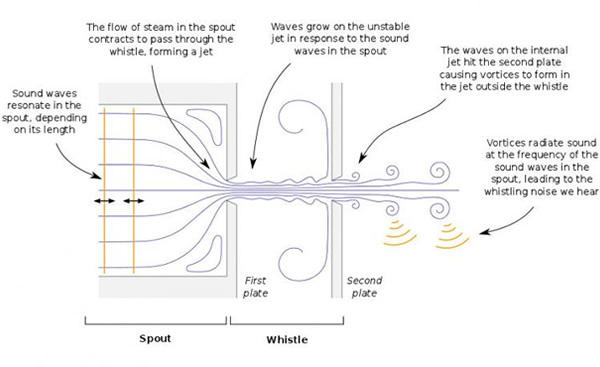
In a basic sense, the reason why a tea kettle whistle when the water inside it reaches boiling temperatures, is obvious (it's the steam, duh!) But the physical source of the noise and the specific reason for the whistling sound had been unknown - until now.
Cambridge physicists Ross Henrywood and Anurag Agarwal made a series of simplified kettle whistles in a rig, then tested them by forcing air through them at various speeds and recording the sound they made. Here's what they found about how the tea kettle whistles:
Their results showed that, above a particular flow speed, the sound itself is produced by small vortices – regions of swirling flow – which at certain frequencies can produce noise.Well, that's neat, you may say, but what's the big deal about figuring that out? Henrywood explained that the whistling effect is actually quite common and figuring out how the sound is made is the first step toward getting rid of it. "The effect we have identified can actually happen in all sorts of situations - anything where the structure containing a flow of air is similar to that of a kettle whistle."
As steam comes up the kettle’s spout, it meets a hole at the start of the whistle, which is much narrower than the spout itself. This contracts the flow of steam as it enters the whistle and creates a jet of steam passing through it. The steam jet is naturally unstable, like the jet of water from a garden hose that starts to break into droplets after it has travelled a certain distance. As a result, by the time it reaches the end of the whistle, the jet of steam is no longer a pure column, but slightly disturbed.
These instabilities cannot escape perfectly from the whistle and as they hit the second whistle wall, they form a small pressure pulse. This pulse causes the steam to form vortices as it exits the whistle. These vortices produce sound waves, creating the comforting noise that heralds a forthcoming cup of tea.
"Pipes inside a building are one classic example and similar effects are seen inside damaged vehicle exhaust systems. Once we know where the whistle is coming from, and what’s making it happen, we can potentially get rid of it," he added.

No comments:
Post a Comment